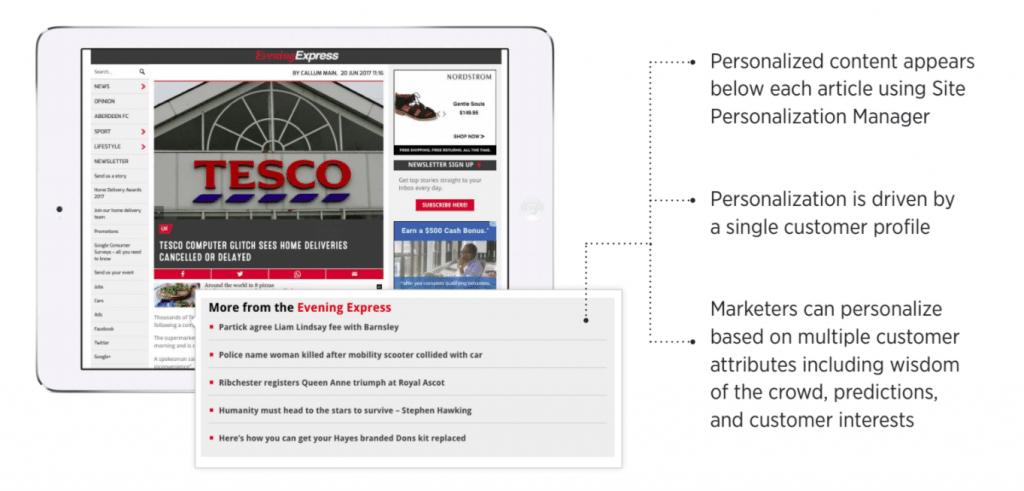Article
How DC Thomson Increased Pageviews Per Session by 20%
February 13, 2018

Most legacy publishers struggle with digital transformation and DC Thomson, founded in 1905, has diversified more than most of its competitors. But with more than a dozen newspapers and magazines (and ecommerce businesses) DC Thomson wasn’t completely confident it was delivering the most relevant content to each visitor.
DC Thomson has been busy trying to build the most compelling online experience to strengthen reader engagement. To do that, the company prioritized 1:1 personalization, creating a superior customer experience by bridging email and the web.
To reach its goals — increasing visitors’ time on site and page views per session, as well as ad revenue — DC Thomson used Site Personalization Manager to provide each reader with a personalized experience. At the same time, editors could still highlight the stories they believe are most important. The mix of algorithm-driven decisions and human editorial input allowed DC Thomson to maximize relevance to each individual site visitor and, at the same time, amplify their brands.
What is Site Personalization Manager?
Site Personalization Manager works by leveraging a single customer profile that pulls data from across channels. In the case of DC Thomson, these customer profiles were constructed by combining information about customers’ preferences, behaviors, and interests, as exhibited both in email and on the company’s websites.

These profiles are used to help select the personalized content that appears below each DC Thomson article on the publications’ websites. For visitors who are new to the site, and for whom profiles had not yet been constructed, Site Personalization Manager uses wisdom of the crowd recommendations (“People who read this article also liked…”) to surface content most likely to be relevant to each particular person.
Site Personalization Manager delivered handsomely for DC Thomson, producing:
- 20% lift in page views per session
- 18% lift in average session time
- 4% decrease in bounce rate.
DC Thomson: Best-in-Class Tactics for Content Personalization
Here’s how DC Thomson produced such solid results.
DC Thomson started by implementing Site Personalization Manager for two of its evening edition media brands. The publisher then tested the effectiveness of Site Personalization Manager — something we always advise — by combining one piece chosen by Site Personalization Manager with one piece chosen via the editorial process. That allowed DC Thomson to test the power of algorithm-driven personalization technology on user engagement.

Readers’ levels of engagement clearly demonstrated that content chosen by Site Personalization Manager was more relevant than content chosen through a more traditional editorial process. That led DC Thomson to make personalized content more prominent in its evening editions online.
Even though personalized content appears in DC Thomson’s emails to readers and on its website, Marigold Engage by Sailthru ensures that the same content never appears in front of the same reader twice. If a reader has already seen a story in their email, Site Personalization Manager will not recommend it again. This provides the reader with a relevant, timely, and catered experience, no matter how often they check their email or visit DC Thomson web sites.
For publishers looking to thrive in a digital era, personalized content is a critical component of creating a compelling customer experience — one that will lead to measurable increases in engagement, and generate persuasive rationales for advertisers to invest in publishers’ success.
The State of Brand Loyalty in the U.S. in 2023
Related



